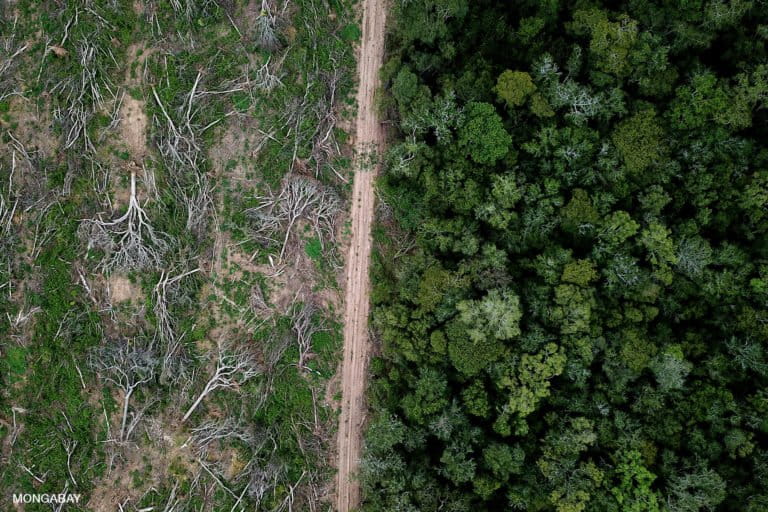- An area of forest roughly the size of California was cleared across the tropics and subtropics between 2004 and 2017 largely for commercial agriculture, finds a new assessment published by the World Wildlife Fund (WWF).
- The report looks at the state of forests and causes of deforestation in 24 “active deforestation fronts”, which account for over half of all tropical and subtropical deforestation that occurred over the 14-year period. These include nine forest areas in Latin America, eight in Africa, and seven in Asia and Oceania.
- Using five satellite-based datasets, the report finds 43 million hectares (166,000 square miles) of deforestation during the period. Nearly two-thirds of that loss occurred in Latin America.
- The report lays out a series of actions to address deforestation, include policy measures by governments and companies. These range from commodity sourcing policies to recognizing Indigenous and local communities’ land rights.
An area of forest roughly the size of California was cleared across the tropics and subtropics between 2004 and 2017 largely for commercial agriculture, finds a new assessment published by the World Wildlife Fund (WWF).

The report, titled Deforestation Fronts: Drivers and Responses in a Changing World, looks at the state of forests and causes of deforestation in 24 “active deforestation fronts” (MAP), which account for over half of all tropical and subtropical deforestation that occurred over the 14-year period. WWF identified these deforestation fronts based on the likelihood that these areas would experience high rates of forest loss between 2010 and 2030. These include nine forest areas in Latin America, eight in Africa, and seven in Asia and Oceania.
Using five satellite-based datasets, the report finds 43 million hectares (166,000 square miles) of deforestation during the period. Nearly two-thirds of that loss — 26.9 million hectares — occurred in Latin America, of which the majority was concentrated in the Brazilian Amazon (15.5 million ha). The Borneo deforestation front ranked second in terms of the extent of forest loss at 5.8 million ha, followed by the Gran Chaco (5.2 million ha), the Brazilian Cerrado (3 million ha), Sumatra (2.5 million ha), the Bolivian lowlands (1.5 million ha), the island of New Guinea (1.3 million ha), and then Myanmar (1 million ha).
The report estimated that a sixth of the total forest area in 2000 was burned at least once since 2002. Dry tropical forests were particularly vulnerable to fire.
WWF warned that forest degradation, from fire, but also selective logging and fragmentation affects extensive areas and often precedes outright deforestation.
Learn more: Rainforests: 11 things to watch in 2021
How the pandemic impacted rainforests in 2020: a year in review
How much rainforest is being destroyed?
WWF also assessed drivers of deforestation, including both direct drivers like forest conversion for industrial agriculture, plantations, infrastructure, and urban expansion, as well as indirect drivers like policy and macroeconomic factors. Like other research, it found that drivers of deforestation vary from region to region, but large-scale agriculture is the largest direct driver of deforestation worldwide. Forest clearing for cattle ranching is the single biggest cause of deforestation in the tropics.
The report lays out a series of actions to address deforestation, include policy measures by governments and companies. These range from commodity sourcing policies to recognizing Indigenous and local communities’ land rights.
“We know what has to be done: protect critical biodiversity areas and sustainably manage forests, halt deforestation and restore forest landscapes, recognize and protect the tenure rights of indigenous peoples and local communities, support local people to build sustainable livelihoods, enhance landscape governance, and transform our economies, food and financial systems to better account for the value of nature,” wrote Marco Lambertini, Director General WWF International, in the report’s preamble.
“With a strong enough global coalition of the willing – governments, businesses, local communities, Indigenous Peoples, civil society organizations and consumers – we can do it.”

CITATION:
- Pacheco, P., Mo, K., Dudley, N., Shapiro, A., Aguilar-Amuchastegui, N., Ling, P.Y., Anderson, C. and Marx, A. 2021. Deforestation fronts: Drivers and responses in a changing world. WWF, Gland, Switzerland.
Header image: deforestation for soy in the Brazilian Amazon. Photo credit: Rhett A. Butler


















